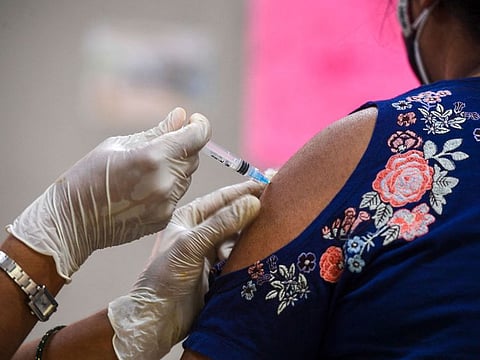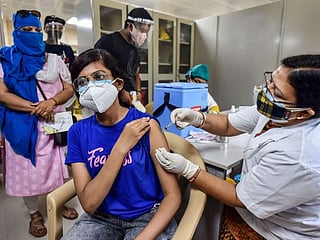Why even with vaccines, COVID-19 will always be with us
Threat of emerging variants may weaken effectiveness of immunisations

Washington: The road to eliminating COVID-19 is long and paved with uncertainty. Many countries are counting on vaccines to build sufficient immunity in their populations so that SARS-CoV-2 isn’t able to find susceptible people to infect, causing transmission of the coronavirus to slow and eventually stop.
But even with the rollout of highly effective vaccines, immunisation coverage may not reach that level - the so-called herd immunity threshold - anytime soon. For one thing, it’s not known what level of immunity is required. There’s also the threat of emerging coronavirus variants that may weaken the effectiveness of immunisations.
1. Can COVID-19 be eradicated?
No. So far, only one human disease - smallpox - has been officially eradicated; that is, reduced to zero cases and kept there long-term without continuous intervention measures. Smallpox was stamped out thanks to a highly effective vaccine and the fact that humans are the only mammals that are naturally susceptible to infection with the variola virus that causes the disfiguring, sometimes deadly disease.
Humans are the only known reservoir of polio virus, yet it still spreads in a few countries, causing paralysing disease, despite the widespread use of effective immunisations and a 32-year-old global eradication effort. SARS-CoV-2 is thought to exist in nature in horseshoe bats, and has been known to infect minks, cats, gorillas and other animals. Wiping out the virus would require banishing it from every susceptible species, which isn’t feasible. In countries that have successfully suppressed COVID-19 cases, disease elimination has been proposed instead.
What’s elimination?
It’s when efforts to suppress an outbreak have resulted in zero new cases of a disease or infection in a defined area over a sustained period. There’s no official definition of how long that should be. One proposal is to make it 28 days, corresponding to twice as long as the outer range of SARS-CoV-2’s incubation period - the time between infection and the appearance of symptoms.
Some countries, such as New Zealand, have achieved zero new cases for lengthy periods using border closures, lockdowns and diligent case detection and isolation. But as that country has showed, sustaining nationwide elimination of any infectious disease is challenging, if not impossible, because of the threat of the virus re-entering the country from infected travelers.
Will vaccines eliminate COVID-19?
It’s hard to say. It’s not known what proportion of the population needs to have immunity to stop the coronavirus from circulating, or whether even the most potent vaccines will be able to prevent it from spreading. One study estimated that to stop transmission, 55 per cent to 82 per cent of the population would need to have immunity, which can be achieved either by recovering from an infection or through vaccination.
However, herd immunity wasn’t achieved in Manaus, the capital of Amazonas state in Brazil, even after an estimated 76 per cent of the population had been infected. That’s because many people were re-infected with a new variant that evaded virus-halting antibodies generated in response to their initial SARS-CoV-2 infection. Still, there’s reason to believe mass inoculations will have a more powerful effect because vaccines appear to elicit stronger, broader and more durable protection than a prior infection.
How effective will vaccines be?
There’s good real-world evidence from Israel, the UK, US and Qatar that vaccines will be highly effective at preventing recipients from developing a serious case of COVID-19, including from an infection caused by a so-called SARS-CoV-2 variant of concern. Observational analysis in Israel, the first country to report national data on the Pfizer-BioNTech vaccine, showed that two doses provided more than 95 per cent protection against COVID-19 infection, hospitalisation, and death, including among the elderly, at a time when the B.1.1.7 variant was the dominant strain.
Separately, researchers there found vaccinated individuals who tested positive for SARS-CoV-2 had a lower viral load, probably making them less infectious and less likely to experience severe illness. The quantity of infectious virus people “shed,” or emit in respiratory particles, is an indicator of their propensity to spread it.
Is that encouraging?
Yes, because the gold standard in vaccinology is to stop infection as well as disease - providing so-called sterilising immunity. But it’s not always achieved. The measles vaccine, for instance, prevents infection so that vaccinated people don’t spread the virus, whereas the vaccine for whooping cough does a good job protecting against serious disease but is less effective at stopping new infections.
Encouragingly, early analysis suggests some vaccines will prevent spread. In Israel, the effectiveness of the Pfizer-BioNTech vaccine at preventing asymptomatic infection was estimated at 91.5 per cent, with the protective effect varying from 85.9 per cent in seniors over 65 years to 92.8 per cent in vaccines ages 16 to 44.
Although further studies are needed to determine the extent to which immunization prevents people from developing asymptomatic infections and transmitting the virus to others, the Israeli experience suggests that high vaccine coverage might provide a sustainable path towards resuming normal activity.
How do variants of the virus factor in?
The more SARS-CoV-2 circulates, the more opportunity the virus has to mutate in ways that enhance its ability to spread and stick around longer and to evade immunity from natural infection and vaccination. Pressure on the virus to select for variants that can still transmit despite immunity from natural infection or vaccination and cause mild infection will probably be a feature of the pandemic coronavirus in the years ahead, researchers in South Africa said.
That will make stopping transmission even more challenging. In recent months, more-infectious variants first reported in the UK, South Africa and Brazil - where COVID-19 epidemics have been particularly severe - have proliferated and spread internationally, causing growing concern. Scientists say the shots should still work at stopping severe disease in the vast majority of cases, but some inoculations may be less effective at protecting against mild infections caused by at least one variant.
Researchers have warned that inoculations may need to be updated periodically to maintain their efficacy, and several vaccine makers have begun testing new versions and booster shots.
Do COVID-19 vaccines have to prevent infection to curb cases?
No. Vaccines don’t have to be perfect to have a public health benefit. New Zealand vaccinologist Helen Petousis-Harris points to rotavirus and chickenpox as examples of diseases that have been “virtually eliminated using vaccines that are very good at preventing severe disease, quite good at preventing any disease, but that do not completely prevent infection in everyone.”
Since SARS-CoV-2 spreads through respiratory particles from an infected person’s throat and nose, a vaccine that reduces the amount of virus in the respiratory tract or how often an infected person coughs may decrease the likelihood of it being transmitted to others and lower the effective reproduction number (Re), which is the average number of new infections estimated to stem from a single case.
Mike Ryan, head of the World Health Organisation’s emergencies programme, told reporters Jan. 25 that rather than focusing on eliminating SARS-CoV-2, success should be seen as “reducing the capacity of this virus to kill, to put people in hospital, to destroy our economic and social lives.”
What if COVID-19 isn’t eliminated?
David Heymann, chair of the WHO’s Strategic and Technical Advisory Group for Infectious Hazards, warned at the end of 2020 that “it appears the destiny of SARS-CoV-2 is to become endemic.”
Viruses that are endemic continuously circulate in the community, often causing periodic spikes when disease characteristics and human behavioral patterns favor transmission. Examples include norovirus, the notorious cause of gastroenteritis on cruise ships, and the myriad of viruses, including four coronaviruses, that cause the common cold, especially over the winter.
What might the implications be?
People who have survived COVID-19 and those vaccinated against it will probably be protected against the disease for some time. Scientists at the Fred Hutchinson Cancer Research Centre in Seattle found blood sera collected from patients who had recovered from a SARS-CoV-2 infection early in the pandemic displayed “generally weak” neutralizing ability against the virus 4-8 months later.
But a single immunization with a so-called mRNA vaccine from either Moderna or Pfizer-BioNTech boosted immunological memory, with the concentration of neutralising antibodies increasing about a thousand fold.
Importantly, they found those antibodies appeared potent against the South African variant. It’s likely that re-exposure to the virus via a natural infection will also bolster protection. As more and more people develop immunity, the virus will find those who are not yet immune, so long as herd immunity isn’t established to protect them.
That will mean that people who can’t get vaccinated - because their immune systems are compromised, or they have allergies to vaccine ingredients, or are too young (none of the vaccines authorized in Western countries have been approved for children) - will remain vulnerable. Some scientists have predicted that, once the endemic phase is reached and primary exposure to the virus is in childhood, SARS-CoV-2 may be no more virulent than the common cold.
Sign up for the Daily Briefing
Get the latest news and updates straight to your inbox









